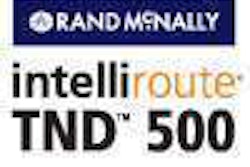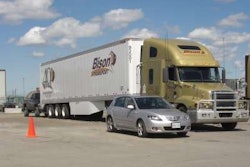 Wheels on the road … that’s essentially the role your shop plays in your trucking business. But shops can be chaotic places, so getting a handle on shop performance and productivity is a nonstop process – one that can pay huge dividends in vehicle utilization and revenue.
Wheels on the road … that’s essentially the role your shop plays in your trucking business. But shops can be chaotic places, so getting a handle on shop performance and productivity is a nonstop process – one that can pay huge dividends in vehicle utilization and revenue.
Defining your terms
The task starts by establishing what productivity means for your shop and your fleet operation. Different managers have different priorities and metrics. For Steph Sabo, maintenance manager for Norrenberns Truck Service in Nashville, Ill., shop productivity is simple: As many permanent repairs made correctly in the cheapest, quickest way possible, in a given work period. For him, that boils down to good leadership.
“Someone in your organization has to know what each person is doing and if they are doing it in an efficient manner,” Sabo notes. “So, to me, productivity starts with the shift supervisor and is a chain all the way up to director of maintenance, with everyone remembering what the group’s main purpose is – keep our equipment rolling with as minimal cost as possible. But what it takes to make that truly happen is extremely difficult.”
Another way to look at productivity is the amount of time a technician spends in his bay working on trucks, versus the amount of time he’s on the clock, says Mark Martincic with Keith Ely and Associates, a consultancy group that provides dealer and fleet management training and support. The big issue isn’t the time spent actually working on trucks versus performing other tasks or even not really working at all, Martincic says, adding that most techs tend to be efficient on that score. “But the problem is managing them when they’re in the bay when they’re working on trucks.”
Ed Pritchard of Anheuser-Busch distributor Silver Eagle Distributors admits that he struggles with how to define productivity and efficiency, especially in a private fleet setting. “When it comes to efficiency, we use a given number of technicians performing regularly scheduled preventive maintenance on a given number of vehicles as our baseline,” says Prichard, senior vice president of Houston-based Silver Eagle. “What complicates this is that the same technicians also are responsible for handling unscheduled repairs or breakdowns when they occur. It also can be confusing to figure out how efficient a particular technician might be when performing preventive maintenance services.”
At the most basic level, you need to assess not only technicians’ efficiency based on the number of PM services they complete within a given period of time but also their quality and thoroughness based on the number of component failures or breakdowns that occur between scheduled PM services, Pritchard says. A fleet might summon the truck principally for oil and filter changes or for clutch or brake inspections. “At the same time, we’re looking for safety-related items, DOT compliance issues, batteries condition, alternators output, starter draw, cooling system condition and much, much more in an effort to spot any potential problems that could fail before the next scheduled service. Any one of those things can keep a truck in the bay longer than we’d like.”
To assess this broader performance, Silver Eagle gauges its shop efficiency by accounting for 90 to 100 percent of hours billed and making sure that the same percentage is accounted for on actual repair orders, Pritchard says. Tying efficiency measurement directly to quality helps Silver Eagle achieve a low percentage of unscheduled repairs and vehicle breakdowns. “Our target range for breakdowns is 1 percent based on miles run, realizing that we need to be realistic with our expectations.”
Silver Eagle tracks its labor and expenses – parts and supplies – by unit on a monthly basis, meaning month to date (MTD), year to date (YTD) and life to date (LTD). “When I refer to the 1 percent target, that means we don’t want our specific unit-related maintenance costs to exceed 1 percent over the LTD for nonscheduled maintenance or breakdowns,” Pritchard notes. “This means our preventive maintenance inspections (PMIs) need to be extremely effective in terms of identifying potential vehicle component failures before they happen on the road.”
Keeping track of techs
Your key metrics of efficiency are only as good as the system you have for tracking activity in the bay. Martincic teaches his clients to map out their current processes to identify obstacles, and to eliminate as many of those as possible on paper. “The next step is to then train your people and start implementing those changes,” he says, acknowledging that fleet managers must be willing to adjust to changing situations. And it’s important to establish a baseline of performance metrics – trucks serviced per day, time per repair, etc. – before implementing the new system so that you can determine whether or not you are improving, Martincic says.
“We track a lot of things and have a lot of monthly measurements in place,” says David Foster, vice president of maintenance for Southeastern Freight Lines in Columbia, S.C. “We’re constantly looking at our direct versus indirect labor in all of our shops. And then, to make sure that everybody is on the same page, we take different-size operations and group them together so we’re comparing similar shops – things like direct and indirect labor and their operations versus a medium-size shop.”
Southeastern closely monitors the time a technician actually spends to complete a repair order, compared to indirect labor that might be waiting on a part or cleaning. “You have to have a good standard system in place to be able to track all of this information,” Foster notes. “We have a computerized maintenance system that we’ve had for almost 20 years. It’s VMRS-based, which we’ve been using since the ’70s when it was still on paper.”
While measurement and managing are important, too much data tracking can be a productivity killer, Sabo cautions. A few years ago, Norrenberns Truck Service started trying to log every aspect of a technician’s day. Eventually, the company realized that technicians were doing too much data entry, cleaning and so on, Sabo says. “That wasn’t productive. A tech’s job is to turn wrenches.”
But Silver Eagle has found that information technology can help a fleet keep technicians focused on working while still gathering key information from and providing information to the technician. A few years ago, the fleet adopted a handheld device option offered by Arsenault for its Dossier solution. The handheld unit goes where the technician goes, allowing him to access information on any unit from Silver Eagle’s main service, Pritchard says. And if a technician needs a part from inventory, he uses the handheld device to scan a barcode on the parts bin and then scans the barcode on the vehicle. “The parts are charged out to the vehicle, and our inventory is automatically adjusted accordingly.” (For more on how technology can help with shop productivity, see “Tuning up the shop,” Technology, July 2009.)
Perhaps one of the best ways to keep technicians productive is to make their paths clear, keeping things simple. “Having a tech wandering around the shop trying to find stuff will kill your productivity,” Sabo says. “Some shops went to Six Sigma, practice ‘FiveS’ philosophy and redid their shop layouts. But to me, that’s just a fancy way of teaching what we were taught in grade school – ‘There’s a place for everything and everything’s in its place.’”
An ongoing reassessment
Southeastern Freight Lines always is looking for best practices throughout its operation and apply them at other shops, Foster says. And although the company is big on standardization of repair procedures, technician feedback is vital for improving productivity.
Technicians on the floor often have good ideas for changing procedures, Foster says. “We listen and look hard at what they say, and if the idea is valid, we try to make sure we implement that same suggestion throughout all of our shops so that everyone is doing it the same way.”
Pritchard cautions that regardless of the metrics or system, fleet managers always must keep in mind the most important goals: quality and safety. “We don’t want a wheel coming off one of our trucks because a technician was rushed to complete a brake job within the allotted time.” Managers need to understand and embrace the necessity to perform the job correctly, Pritchard says. “On the other hand, if you have a technician who is consistently off-schedule because they spend too much time socializing, then we have processes in place to initiate corrective action.”
Martincic agrees that frequent coffee and cigarette breaks, cell phones, conversation and other distractions can be a big drain on productivity. But while he doesn’t like to see technicians wandering around a shop, he believes that’s exactly what managers should be doing. “I’m a believer in management by wandering around,” Martincic says. “I think you need to step out of that office a few times a day and walk the floor and see what’s going on – particularly from an objective view or even a customer’s or outsider’s view.” Look for and correct productivity parasites, he advises.
Particularly at high-volume shops, such as dealerships or larger fleets, productivity often begins outside the shop bay, Martincic says. “It’s like the old TV show ‘M*A*S*H’ – the parking lot becomes like your triage room where you prioritize jobs that need to be done,” he says.
Fleet managers also need to assess potential investments in shop equipment that could improve productivity. Silver Eagle recently invested in a variety of vehicle lifts that have boosted technician efficiency, Pritchard says. “For the smaller vehicles, we installed stationary rotary lifts because they don’t take up much floor space,” he notes. “For the heavier vehicles, we brought in portable column lifts because we wanted the flexibility to free up space when we don’t need them.” When compared to jack stands, lifts have provided better ergonomics and safety, leading to increased productivity and quality, Pritchard says.
Foster argues that there’s one other productivity enhancer that is fundamental and that fleets simply can’t ignore: Training. “We see training as a win-win, because from our technician standpoint, it builds personal development and professional development. And as a company, we reap those benefits and see increased productivity.” Training helps keep technicians motivated and working for your fleet, Foster argues. “They know technology is moving forward, we’re moving with it, and we’re going to take them along with us.”
And in the end, a stable, well-trained and motivated technician force might just be your most important productivity asset of all.









